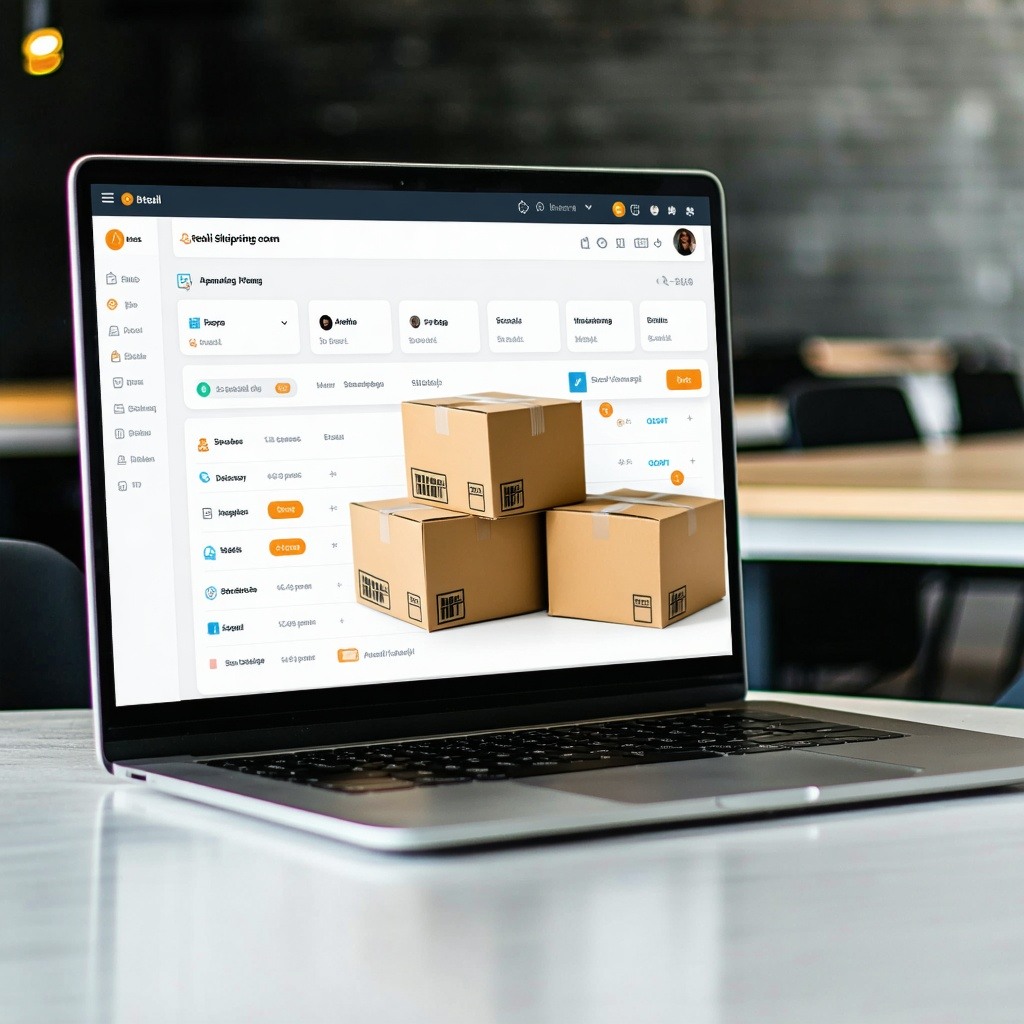Shipping Software for Retail: Challenges and Solutions

What we’ll cover
Introduction
In today's fast-paced retail environment, efficient shipping is the cornerstone of customer satisfaction and business success. With the rise of e-commerce and omnichannel shopping, retailers face unprecedented challenges in managing their shipping processes. A recent study revealed that supply chain disruptions, rising shipping expenses, and delivery delays are among the top concerns for retailers.
To navigate these complexities, many are turning to sophisticated shipping solutions or shipping software designed to streamline operations and enhance efficiency. Some of the best shipping software options are helping brands reduce shipping costs by offering discounted shipping rates. They are also helping them improve delivery quality with streamlined shipping workflows, branded tracking pages, and advanced shipping apps. This article provides you with all the information you need to a choose shipping software.
Core features to look for in retail shipping software
To effectively address shipping challenges, retailers should consider the following essential features when they choose an shipping software to enhance their shipping services:
1. Multi-carrier shipping integration:
Access to a wide range of carriers provides flexibility and better cost control. With the help of multi-carrier shipping software, retailers can get real-time integrations to choose the most suitable shipping options based on destination, cost, and delivery speed, and speed up generation of shipping labels.
2. Shipping rate optimization:
Comparing shipping rates in real-time enables the selection of the most cost-efficient option. This feature helps retailers in cost savings. Retailers can compare carrier rates and find discounted rates and exclusive shipping discounts from the best shipping solution providers.
3. Real-time shipment tracking:
One of the key features to look for is a consolidated dashboard with real-time updates for seamless tracking. It helps ecommerce businesses with enhanced visibility through delivery notifications. Retailers can monitor shipments across all carriers, which will ensure timely deliveries and proactive communication with customers.
Related read: Best 15 Shipment Tracking Software and Tools in 2025
4. Automated returns processing:
Self-service return portals simplify the returns process. Automation in returns management improves customer experience and reduces the workload on customer service teams.
5. International shipping compliance:
Built-in tools for handling customs, duties, and taxes ensure compliance in case of international shipments. This feature minimizes delays and penalties associated with international services. It is a must-have for businesses with global networks and those looking to manage import orders.
6. AI-powered delivery predictions:
Accurately predicting delivery times reduces failed delivery rates. AI-driven insights allow retailers to provide customers with reliable delivery estimates. It enhances trust and satisfaction.
Key challenges facing retailers in shipping & their solutions
Despite technological advancements, retailers continue to face significant shipping challenges. Addressing these issues is crucial for maintaining competitiveness and customer loyalty.
🚨Challenge #1: Managing multi-channel orders efficiently
Retailers today are rarely confined to a single sales channel. From direct-to-consumer ecommerce platforms and online marketplaces to in-store orders and mobile apps, the modern retail landscape thrives on omnichannel presence. While this widens reach and boosts conversions, it also complicates shipping operations. Juggling multiple sales channels without unified control often leads to delayed deliveries, fulfillment errors, and poor customer experiences.
Issue: Retailers often sell products through various channels, including e-commerce platforms, marketplaces, and physical stores. Coordinating orders from these diverse sources can lead to inefficiencies and errors.
Heavy and oversized shipments may be designated as hazardous material. Hazmat shipments or those like them often incur higher freight charges, require specialized carriers, and face loading restrictions. Failure to optimize freight selection can lead to shipment delays, additional surcharges, and even cargo damage due to improper handling. Moreover, inefficient shipment planning results in underutilized truck space or costly multiple shipments instead of consolidated freight movement.
✅ Solutions
-
Centralized Order Management System (OMS): Implementing a centralized OMS synchronizes orders across all platforms. It provides a unified view and streamlines fulfillment processes.
-
Automated carrier allocation: With multi-carrier shipping solutions, automating the selection of carriers based on predefined criteria becomes easy. It ensures timely deliveries and optimizes shipping costs.
-
AI-driven carrier selection: Utilizing AI to select the best carrier for each channel based on performance metrics enhances delivery efficiency and workflow automation.
🚨Challenge #2: Rising shipping costs & budgeting issues
Shipping is one of the most significant operational expenses for any retailer. With fluctuating fuel prices, surcharges, packaging costs, and increasing customer demands for free shipping, retailers find their profit margins consistently shrinking. Without smart cost-control mechanisms in place, shipping quickly becomes a financial drain rather than a customer value-add.
Issue: Fluctuations in fuel prices and additional surcharges contribute to escalating shipping costs. It impacts profit margins.
Cross-border and international shipments face logistical roadblocks, including customs clearance delays, inconsistent documentation standards, and tracking challenges. Without proper planning, shipments can get held up due to incorrect or missing shipping documents, resulting in longer transit times and unexpected fees. Additionally, coordinating multiple orders across different locations without automation can lead to inefficiencies in warehouse allocation and inventory mismanagement.
✅ Solutions
-
Dynamic rate shopping: Real-time transparent rate comparisons of carrier discounts and costs allows retailers to choose cost-effective shipping options. Comparing rates and organizing carriers into pricing tiers ultimately reduces expenses and can even provide instant savings.
-
Shipping zones & weighted shipping strategies: Analyzing geographical shipping patterns enables the optimization of shipping zones and implementation of weighted strategies to lower costs.
-
AI-powered cost optimization: Leveraging AI to automate decision-making processes helps identify the most economical shipping routes and methods.
🚨Challenge #3: Poor visibility & tracking across carriers
Small businesses working with multiple carriers often face fragmented tracking experiences. Without a central system to monitor every shipment in real-time, it becomes difficult to keep customers informed, identify delivery issues early, or provide proactive support. This lack of visibility not only impacts operational control but also weakens brand trust.
Issue: Lack of centralized tracking leads to poor visibility, delayed customer communication, and increased "Where is my order?" (WISMO) inquiries.
Without centralized tracking, businesses struggle with shipment visibility, leading to increased WISMO (Where Is My Order?) inquiries. Industrial shipments frequently change hands multiple times, making tracking fragmented and unreliable. Businesses that rely on manual tracking methods struggle with delays in communication, inaccurate estimated delivery dates, and increased costs associated with lost or missed deliveries.
✅ Solutions
-
Unified tracking dashboard: A centralized platform consolidates tracking information from all carriers. It provides real-time visibility.
-
Real-time alerts & notifications: Automated updates keep customers informed about their shipment status. It helps reduce WISMO.
-
Proactive Non-Delivery Report (NDR) automation: Immediate notification of failed deliveries allows for swift resolution and enhances customer satisfaction.
🚨Challenge #4: Handling returns & reverse logistics
Returns are inevitable in retail. However, handling them without a streamlined system can be costly and chaotic. From reverse pickup logistics to inventory reclassification and restocking, the process involves multiple stakeholders and data points. Without automation, the burden of managing returns can compromise both profitability and customer satisfaction.
Issue: Managing returns is complex and costly. It often leads to inventory discrepancies and customer dissatisfaction.
Manufacturers struggle with fluctuating freight charges, fuel surcharges, and inefficient routing. Without proper carrier rate comparison, manufacturers often overpay for freight services or fail to negotiate better deals. Additionally, relying on a single carrier increases the risk of service disruptions and capacity shortages. That leads to higher costs and delayed shipments.
Solutions
-
Automated return management: Self-service portals streamline the returns process. It helps reduce manual intervention and errors.
-
Predictive returns analysis: Identifying return trends aids in improving stock management and reducing return rates.
-
Flexible return policies: Simplifying the return process enhances customer satisfaction and loyalty.
🚨Challenge #5: Customer expectations for faster delivery
The era of instant gratification has made fast delivery the norm. Whether it is next-day or even same-day shipping, customers expect retailers to deliver quickly. For those managing multiple warehouses or servicing wide geographies, meeting these delivery windows requires precision coordination and real-time intelligence across the supply chain.
Issue: Consumers increasingly expect same-day or next-day delivery. That makes it challenging for retailers to meet these demands efficiently.
A delay in the shipping process disrupts B2B operations, affecting both manufacturers and distributors. A minor delay in raw material deliveries can halt production lines, causing financial losses and production bottlenecks. If manufacturers fail to secure priority shipping, they may face unnecessary downtime and a negative impact on customer commitments.
✅ Solutions
-
Same-day & next-day delivery automation: Implementing smart routing and utilizing local warehouses to meet rapid delivery demands.
-
Last-mile delivery optimization: Leveraging local couriers and delivery partners accelerates delivery times.
-
AI-based predictive shipping: Providing accurate delivery dates reduces missed deadlines and enhances customer trust.
🚨Challenge #6: Compliance with tax and duty regulations in global shipping
International expansion brings growth but also complexity. Retailers entering cross-border commerce must navigate a maze of customs documentation, local tax laws, duties, and shipping regulations. Without the right systems in place, delays at customs, unexpected charges, and regulatory fines become common. It can damage both the customer experience and brand reputation.
Issue: Navigating complex international tax laws and customs regulations can lead to delays and increased costs if not managed properly.
Processing returns for bulky, high-value industrial goods is far more complex than standard eCommerce returns. The process involves verifying defects, arranging specialized return shipments, and ensuring regulatory compliance. Without automation, businesses struggle with slow return processing, high costs, and improper handling of returned goods.
✅ Solutions
-
Automated duty & tax calculations: Real-time updates ensure compliance with international tax regulations.
-
Customs clearance automation: Streamlining documentation reduces delays at customs.
-
International carrier integration: Direct integration with global carriers facilitates smoother cross-border operations.
How ClickPost helps retailers scale shipping automation
ClickPost is a leading retail shipping software that assists retailers in automating and optimizing their shipping processes. Key features include:-
ClickPost standout features:
-
Seamless integration: Connects with multiple carriers, offering flexibility and cost control.
-
Real-time tracking: Provides a unified dashboard for monitoring shipments, enhancing visibility.
-
Automated returns management: Simplifies the returns process with self-service portals.
-
AI-powered analytics: Offers insights into shipping performance and cost optimization.
With our platform, you can save time and money using a user-friendly interface to manage orders. This is supported by automation rules for carrier allocation, delivery date prediction, generation of branded labels, and other additional features like scheduled pickups. By leveraging ClickPost, retailers can streamline their shipping operations, reduce costs, and enhance customer satisfaction.
Streamline your shipping experience with ClickPost

The final thoughts
Navigating the complexities of retail shipping requires a comprehensive approach that addresses both operational challenges and customer expectations. Implementing robust shipping software with essential features can transform these challenges into opportunities for growth and efficiency. As the retail landscape continues to evolve, staying ahead with innovative shipping solutions will be key to maintaining a competitive edge.